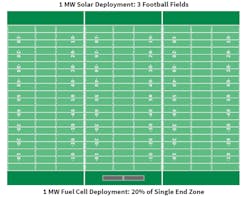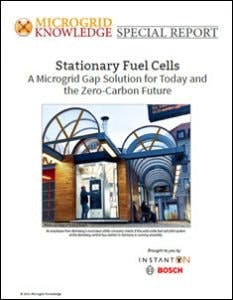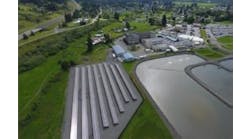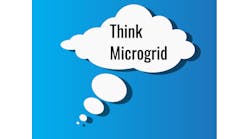In a new special report series brought to you by Microgrid Knowledge, Instant On and Robert Bosch, we explore how fuel cells can be a microgrid gap solution that fills the power gap, the fit gap and the sustainability gap. Here we offer a bonus article with content from the report explaining how fuel cells can help with the transition to the energy future.
Download the full report.
The first choice for a quick reliability option to fill the power gap today is often diesel generators, but climate commitments at the federal, state and company level as well as local air quality regulations make them less viable moving forward. A better Microgrid Gap Solution also fills the fit gap and sustainability gap.
Stationary fuel cells can run on natural gas, which is readily available and cleaner than the diesel used by diesel generators, and they are 1.5-2 times more efficient than diesel generators. Where sources of green hydrogen and renewable biogas are available, fuel cells are already using these fuels to deliver electricity with even lower carbon emissions. Importantly, the efficiency remains high even as different kinds of fuel sources are blended into the mix or replace natural gas entirely.
Solar PV combined with battery storage microgrids are ascending as a new zero-carbon reliability solution of choice. However, they are not the Holy Grail for all situations.
Many customers operate in a low sunlight region or space-limited facility in which a solar and battery storage-based microgrid won’t deliver the power needed.
To demonstrate the space constraint, consider that a 1-MW solar PV system in a region with adequate solar resources would require a surface the size of three football fields with direct access to sunlight. The same 1 MW from fuel cells would require about 20% of a single end zone and can be installed almost anywhere, such as in basements or underutilized buildings. A solar MW and a fuel cell MW are not created equal either. One MW of installed solar capacity produces about 1.5 MWh of electricity per year. One MW of solid oxide fuel cell capacity generates about 8.8 MWh.
A comparison of the surface area needed for 1 MW of installed solar capacity and 1 MW of solid oxide fuel cell capacity. Source: Robert Bosch
This means solar and battery combinations are not a solution for energy resiliency for commercial and industrial (C&I) customers with office and retail spaces in high-rise buildings or data centers in cities. Solar simply can’t deliver the necessary energy intensity given the space limitations. Fuel cells can play a major role serving these scenarios.
Case in point: Community-scale microgrids
Community-scale microgrids show the challenge of battery storage as a 100% resiliency solution.
Consider the Goleta Load Pocket Community Microgrid in California. As part of an ambitious project to deploy a community microgrid that will help avoid outages because of fires, earthquakes, mudslides and other disasters in the load pocket, the 40-MWh Vallecito Energy Storage Resilience (VESR) project was brought online in December 2020 as the initial phase of the Goleta project.
However, the VESR project only provides 10% of the total MWh required for 100% resilience. In order to achieve that requirement, the wildfire and mudslide prone area needs 200 MW of solar and 400 MWh of storage.
This points to the need to have a solution with greater power density, such as fuel cells, for community-level resiliency from microgrids. However, it’s not a “one or the other” problem. Because fuel cells integrate seamlessly with advanced microgrids and renewable DERs, their deployment can be right-sized with solar and battery systems, depending on needs. In the case of the VESR project, it could be optimized for cost, 100% resilience and sustainability by considering a combination of solar, battery and fuel cell solutions.
A fit for the net-zero future
The needle in US energy use is pointing toward net-zero carbon emissions by 2050, with many states and communities aiming to get most of the way there by 2030. In this environment, installing a new carbon-emitting DER in the 2020s doesn’t make sense — even if it is lower emitting than diesel-powered alternatives.
For more information, download the full report.
That’s why the fuel flexibility of fuel cells is a critical advantage to fill the sustainability gap that stands between the power solutions of today and net zero. Cleaner than today’s diesel generators running on natural gas, sources of low- and no-carbon hydrogen and renewable biogas can be mixed into the natural gas supply to the fuel cell with marginal impact on performance as supply of those fuels ramps up. The fuel cells will remain highly efficient, providing electricity and heat that gets cleaner as the fuel mix transitions. Ideally, the fuel supplied to the fuel cell will transition to zero-carbon hydrogen, making the system truly emissions-free.
As an example of the progress being made, Southern California Gas in 2021 is launching the first US demonstration of green hydrogen produced by solar power and then converted back into electricity via fuel cells. The solar-powered green hydrogen is also blended with natural gas to fuel traditionally gas-fired home appliances.
Cleaner than today’s diesel generators running on natural gas, sources of low- and no-carbon hydrogen and renewable biogas can be mixed into the natural gas supply to the fuel cell with marginal impact on performance as supply of those fuels ramps up.
In five to 10 years, sources of green hydrogen are expected to be much more widely available. By one estimate, global green hydrogen capacity is expected to rise 280 times by 2030, with the price falling 40% by 2025. In the US, the Biden administration in June 2021 launched the Hydrogen Energy Earthshot initiative, aiming to reduce the cost of clean hydrogen to $1 per kilogram in one decade. As those estimates are realized, customers will be able to source no-carbon hydrogen to make their solid oxide fuel cells generate carbon-free electricity.
In fact, customers with the right combination of microgrid DERs could even provide their own green hydrogen supply, maximizing their energy efficiency in the process. When combined with solar power and other renewable generating assets in a microgrid, excess power during periods of high sunlight or wind could be used to drive the electrolysis process and generate green hydrogen for later use by the fuel cell. It’s an alternative to battery storage and though the technology is not commercially ready today at smaller scales, it is on the way. This on-site green hydrogen production alternative has great potential for larger systems, considering hydrogen can be stored for much longer periods than electricity in a battery. Reversible fuel cell systems that can be used to generate hydrogen or electricity in a single application are already in development.
To learn more about how fuel cells can be a microgrid gap solution, check out the previous articles in the series below:
Stationary Fuel Cells Are a Microgrid Gap Solution
Customers Need a Microgrid Gap Solution. Fuel Cells Are It.
Solid Oxide Fuel Cells: A Definitive Guide
Fuel Cells Offer a Transition to — and a Product for — the Energy Future
The Business Model for Fuel Cells Is a Win for Customers and Installers
Download the full report, “Stationary Fuel Cells: A Microgrid Gap Solution for Today and the Zero-Carbon Future,” courtesy of Instant On and Robert Bosch to learn more.








